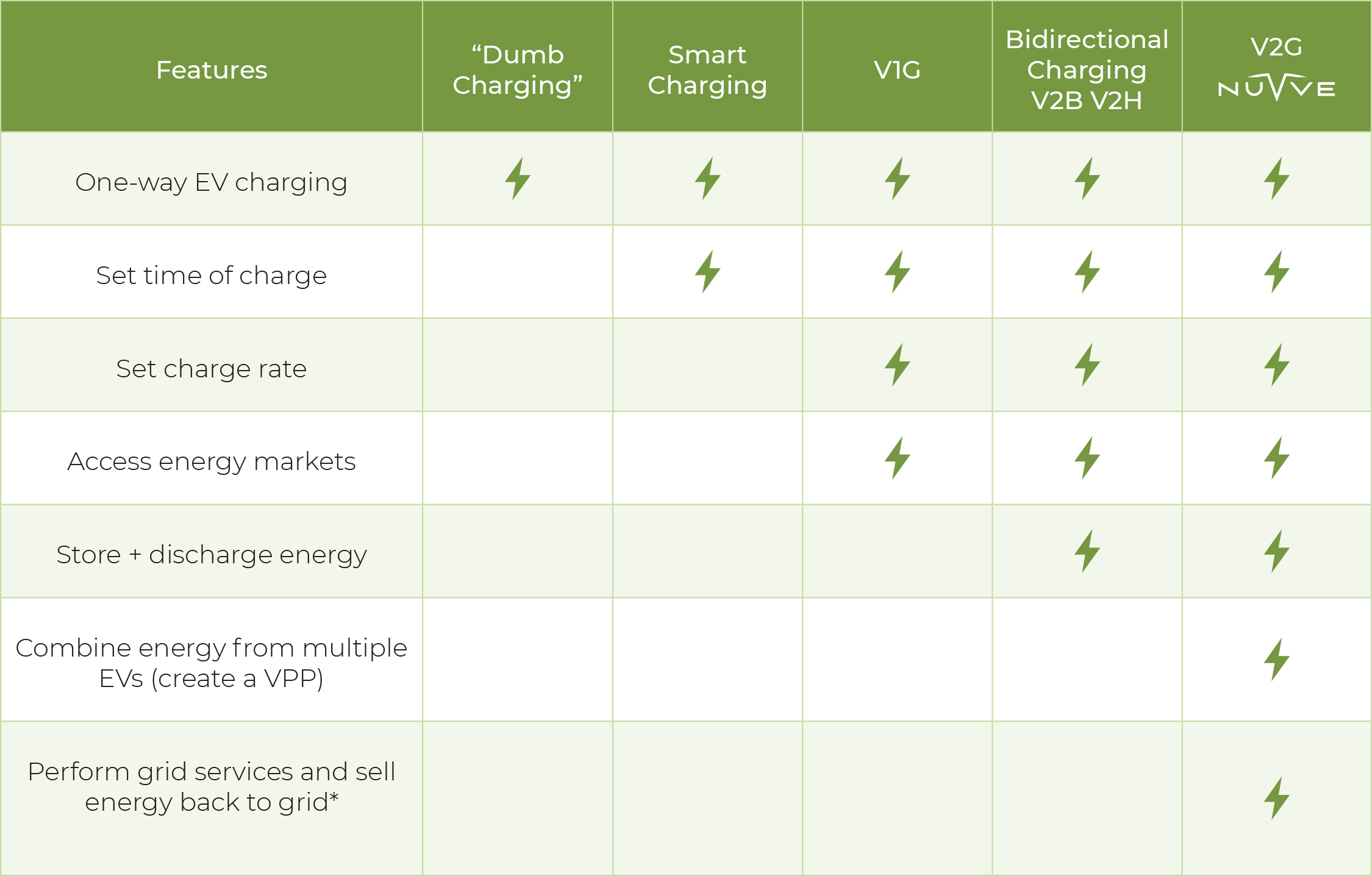Nuvve has 24/7 monitoring. Some problems can be handled by Nuvve remotely through a software connection. On-site charging station repair issues are quickly serviced using a network of trained representatives. If you are experiencing issues, please go to support.nuvve.com or email our team at support@nuvve.com.
Nuvve’s V2G software technology requires a pairing between a V2G charger (AC or DC) and a vehicle that has been enabled by its manufacturer for both charging and discharging energy from it. Nuvve is working closely with auto manufacturers and charger manufacturer companies to ensure this happens at the production level. Nuvve is also working with auto manufacturers on R&D related to V2G.
United States: Fleet Solutions
– Blue Bird Vision (Type C) and Blue Bird All American (Type D)
– Custom Electric Heavy-Duty Vehicles
United States: Residential Solutions
– Nissan LEAF Model Year 2013 and newer – Coming Soon
– Mitsubishi Outlander PHEV – Coming Soon
Europe: Fleet + Residential Solutions
– Nissan LEAF Model Year 2013 and newer
– Nissan e-VN200
– Mitsubishi iMieV
– Mitsubishi Outlander PHEV
Currently the Blue Bird Vision (Type C) and Blue Bird All American (Type D) are V2G compatible. Additional products are planned for the future. Check with your bus manufacturer for the available models and upcoming launch dates.
AC charging relies on an on-board charger inside an electric vehicle to charge the battery. For electric vehicles such as school buses, the on-board charger is usually 19.2kW. In order to provide 19.2kW of power, it requires 80amps of capacity with 240V (80amps x 240volts = 19,200 watts). It’s still possible to charge a bus with lower voltage or a lower-rated charging station, but it will take longer to charge the bus.
DC charging can be a fast way to charge large electric vehicles including electric school buses. The charging stations can be designed for different-sized vehicles depending on their power ratings. Nuvve offers a 60kW DC option because it is a good balance of size, cost, and charge time for heavy-duty vehicles.
Smart charging, sometimes called V1G, refers to the ability to dynamically modify the charge rate or the charge time. This can help minimize the cost of charging a vehicle if a rate schedule is based on time of use (TOU), such as middle of the night versus peak demand hours.
Vehicle-to-grid (V2G) refers to bidirectional energy flow between an electric vehicle’s battery and the charging station. Energy can be transferred to a building (vehicle-to-building or V2B) the charging station is connected to in order to manage energy costs, or can be sent to the grid (V2G) to earn revenue on energy markets. Similarly, if the building possesses excess energy from solar panels, this energy may be stored in the electric vehicle and re-used at a later time.
See the matrix below for reference.

A DCFC with V2G will help you save money in a more efficient, effective way through the precise control of energy flow in and out of a heavy-duty vehicle’s battery and to the electric grid; besides charging when rates are low, in certain areas, V2G allows vehicles such as electric buses to earn revenue by selling extra energy from their batteries back to the grid.
Government, education, municipalities and nonprofit agencies looking to electrify their fleets now have an easy and immediate access to Nuvve’s charging solutions through the Sourcewell contract. Learn more about how Sourcewell helps to make the buying process seamless and more affordable.
Nuvve has installation partners that provide a full turnkey solution or customers may opt to handle some aspects in-house.
No, the Nissan LEAF is capable of performing V2G charging only on a DC CHAdeMO port with a V2G DC charging station. However, the Nuvve PowerPort can be used for smart charging (V1G) with the Nissan LEAF.
Nuvve developed and deployed a custom integration with select bus manufacturers that enables the bidirectional flow of energy between an electric bus and DC charging station using this type of connector.
By switching to a time-of-use (TOU) rate, we can ensure your vehicle is charged at the time when electricity is least expensive. Additionally, in certain cases, Nuvve will be “selling” the energy from the vehicle batteries back to the grid.
Nothing extra is required to take advantage of V2G with your vehicle charging. Nuvve simplifies the process by ensuring drivers always have the required energy to drive. The only requirement for the fleet operator is to set a schedule for what time the vehicles need to leave each day along with the total daily mileage required. Nuvve’s platform handles the rest.
Evaluate your bus routes to determine if you will have sufficient time to charge with a Level 2 versus DCFC charger. If you plan on growing your fleet, consider future-proofing your charging infrastructure (bus battery capacities keep improving so your charging station power needs to keep up). Choose a charging station that goes beyond “dumb charging” and allows flexibility on scheduling charge times to save on utility costs and more.
Nuvve works within auto OEM battery warranty limits. To learn about the various factors that affect electric vehicle battery health and the ways V2G can help mitigate degradation risks, download the Nuvve Battery Health Paper here.
No, the installation process is the same. However, an interconnection application with the electric utility is required to allow the electric vehicle batteries to discharge electricity to the building (V2B) or to the grid (V2G). Nuvve handles the interconnection application.
No, we can charge any vehicle that accepts DC fast charging, even if the vehicle is not V2G-capable.
Yes. Hard-wired ethernet is preferred but wifi connection is an option.
Currently, Nuvve requires one 60kW charging station per heavy-duty vehicle in order to maximize the V2G value. And while Nuvve is working on this feature for future charging stations, shared DC charging is an expensive solution. A 60kW DC charging station shared among three vehicles will output 20kW per vehicle while a Level 2 AC charger can provide 19.2kW of power at a much lower cost.
While AC charging can be V2G capable, in the U.S., electric buses cannot use AC charging for full V2G bidirectional charging due to the nature of the onboard inverter.
No, the electric bus needs to be V2G-capable, use a CCS1 connector plug, and have technology integrations that allow bidirectional energy flow.


